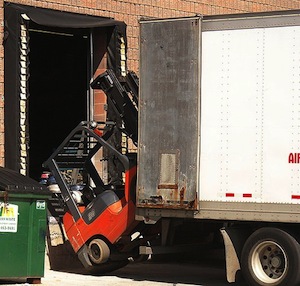- Home
- News
- Know Your Risks at the Loading Dock
Know Your Risks at the Loading Dock
Overall risk is minimized at your facility by implementing safety procedures and issuing personal protective equipment, but how do you protect your employees at the loading dock? The need for safety solutions at this critical location is oftentimes overlooked and underestimated.
So, what makes the loading dock so dangerous? It's a fast paced, high-traffic environment where securing a trailer during loading/unloading is essential but usually lacking. The fact is, trailers at the loading dock can move unexpectedly, exposing your company and employees to a great deal of risk and cost. Millions of dollars are lost each year due to loading dock accidents, from medical and equipment costs to lost production time. And sadly, in the worst cases - lives are lost.

Common trailer separation threats at the loading dock include early departure, landing gear collapse, trailer pop-up, trailer upending, and trailer creep. Rite-Hite has studied all types of loading dock issues and has developed best in class solutions to address these accidents and save lives.
How can you best address the dangers lurking at your loading dock? Let Rite-Hite do the heavy lifting. Rite-Hite created the vehicle restraint industry by introducing the Dok-Lok in 1980. We built it and continue to innovate, expanding on a proven solution with only the highest level of safety and communication in mind. In fact, there is a wide variety of vehicle restraints to help address trailer separation accidents:
Rotating Hook Restraints - proven performance, featuring a unique rotating hook that wraps over the rear impact guard, securing the trailer to the dock addressing all types of trailer separation accidents.
Stabilizing Trailer Restraint - an exclusive vehicle restraint category featuring a unique rotating hook that wraps over the rear impact guard and a method to stabilize trailers, helping to address both the horizontal and vertical movement associated with air-ride suspension trailers.
Vertical Barrier Restraints - ideally suited for “live loading” applications where the semi remains attached to the trailer. The vertical barrier is designed to provide solid, dependable upward pressure to rear impact guards.
Global Wheel Lock - positioned automatically by the trailer tire, this highly versatile wheel based restraint works with virtually any trailer (standard over the road, hydraulic lift gates, drop frames, and low hanging fenders with or without rear impact guards). This restraint secures the trailer tire in place with a solid 20-inch barrier.
Manual Wheel Lock - the simple, versatile, cost-effective wheel based restraint solution. Positioned and locked/unlocked manually by dock personnel it features a tough, rugged design to secure virtually any trailer.
Back to News